|
|
|
|
|
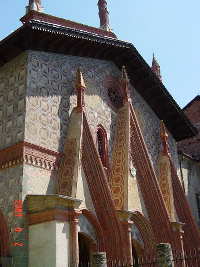
S. Antonio di Ranverso (TO)
|
The Via Francigena is the route coming from "France". In ancient
times, the name was used for different routes that lead to Italy from the North West. The main routes leading to
Italy have been rediscovered and are now used by pilgrims: one route is going to and coming from Santiago de Compostela.
Arriving from Spain and South of France this route enters Italy from the Monginevro Pass, then crosses Val di Susa,
and goes beyond Turin to Vercelli. The other is the route used by pilgrims coming from the North of Europe through
France and across the Great St. Bernard Pass and Aosta it goes to Vercelli as well. |
| Here the routes merge and the road becomes one, it goes to Rome passing
through Pavia, Piacenza, Fidenza, Cisa Pass, Pontremoli, Lucca, Siena, Bolsena and Viterbo. A third route that
starting from Ventimiglia follows the Ligurian Coast reaches the Via Francigena near Sarzana, in Tuscany; many
pilgrims are beginning to use this route. These many stages are full of history about the Via Francigena. |
|
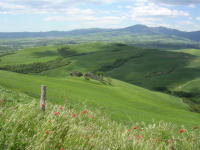
Radicofani (SI)
|
The Via Francigena was recordered for the first time in an ancient document
dated A.D. 876 that was kept in the Abbey of St. Salvatore on Monte Amiata. In this document the route is mentioned
as passing through the area of Val d'Orcia, taking the same route of the Via Cassia, in the stretch of road on
the slope of Radicofani near Posta di Ricorsi. The latin document reads: "... perfossatu descendente usque
in via Francisca".
|
It mentioned Via Francisca, that is the Via Francigena. The document is
a lease by which the monks rented to someone called Gisalprando a farmland that was bounded by a ditch that went
down to border the Via Francigena.
For scholars the first time something is mentioned it is very important: it is like a birth certificate, the first
source. So, in A.D. 876 it was already known that the route from and to France was taking pilgrims and wayfarers
to Rome and either to Jerusalem or Santiago de Compostela: it was alive and called, as nowadays, the Via Francigena. |
To the modern pilgrim the Via Francigena offers many surprises: you may
walk across beautiful landscapes, find wonderful places and people, needless to say that Italy is a beautiful country.
It is important to have a good guide, written by Italians who know the true needs of the pilgrim and who can propose
the best solutions in such a complex reality.
"Guida alla Via Francigena" by Monica D'Atti e Franco Cinti (Terre di Mezzo Editore, Milano, 2006) describes
the route and available facilities in detail. The route has been walked more than once by the authors that were
looking for the best and more logical solutions for the walking pilgrim, being close to the historical route as
much as possible. |
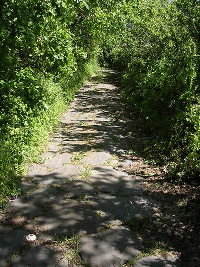
Montefiascone (VT)
|
| Unfortunately in several places the route is not properly marked yet and
often signs designed for tourists can deceive the pilgrim who walks or rides a bike. The indicated hostels have
all been contacted and/or visited personally by the guide's authors. The latest news, information and tips are
available on the web site www.guidafrancigena.it . The Via Francigena is progressing, growing and opening itself
to the true pilgrim. |
|
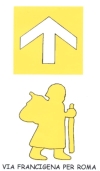
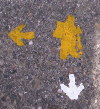
|
Some aspects are very important for the pilgrim who wishes to walk along
the Via Francigena: to know that a group of volunteers called Custodi della Via Francigena" are signposting
the route at their own expenses. The sign is represented by a "pellegrinetto giallo" a small yellow pilgrim,
with a white arrow if the sign is pointing to Rome or a yellow arrow if pointing to Santiago de Compostela. It
has been decided to signpost the route in both directions because pilgrims walk it in both directions. This signs
can be found along the following stretches: from Chivasso to Lamporo, from Vercelli to S. Cristina (beyond Pavia),
from Piacenza to Fomovo, from Pieve di Bordone to Cisa Pass (signposted by C AI, that is Club Alpino Italiano)
and from Sarzana to Rome there will be few signals.
|
Another important aspect to know is which kind of accommodation is available.
Everywhere in Italy it is possible to find hotels, pensions and "agriturismi" holidays farms. Their addresses
can be found in tourist guides and in web sites. For those walking with the traditional spirit of the pilgrim that
take in pilgrims are listed in the guide and signalled in the web site www.guidafrancigena.it Such places are indicated
with the acronym OP (it means "accommodation for poor" or "accommodation for pilgrims"). This
kind of accommodation is suitable for travellers with mat and sleeping bag. The accommodation offered can be anything
from just a space under a roof to a single room or an outbuilding in a farm or a dormitory. Leaving an offer even
if you are not asked to it is a good rule. We recommend you to call a day or two in advance to let know of your
arrival. Many places are not always available. Remember that the pilgrim should have the ability to adapt himself
almost to any situation, should be well behaved and should be patient. Finding "doors open or closed"
might depend on the behaviour of people who have been there before you: this is another way to build up the Via
Francigena.
|
|
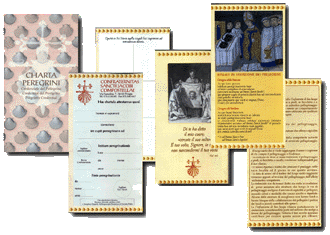
|
We suggest you to bring always the "credential", as pilgrims
do for the Camino de Santiago. You can ask the credential to you Confraternity or to your Diocese. In some places
the credential is required while other places are not yet aware of the existence of such "identification paper
for pilgrims", we believe that having one is a sign of propriety for the true pilgrim. In Italy, the "Confraternita
di San Jacopo di Compostella" in Perugia is pleased to issue such credential for a pilgrimage with spiritual
purposes or "devotionis causa" with true faith.
To sum up this short introduction we wish to invite you to share with
us the emotions you will feel along the route by contacting us at autori@guidafrancigena.it; to find more information,
please read the guide and visit the other web pages in Italian.
|
|
|
|
scroll the block above to see all the text
|
|
|